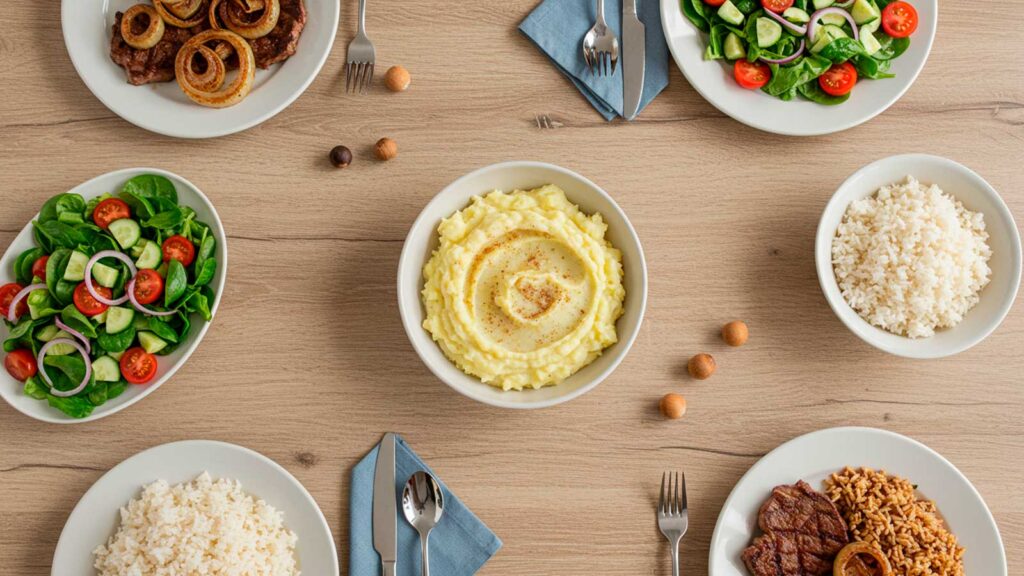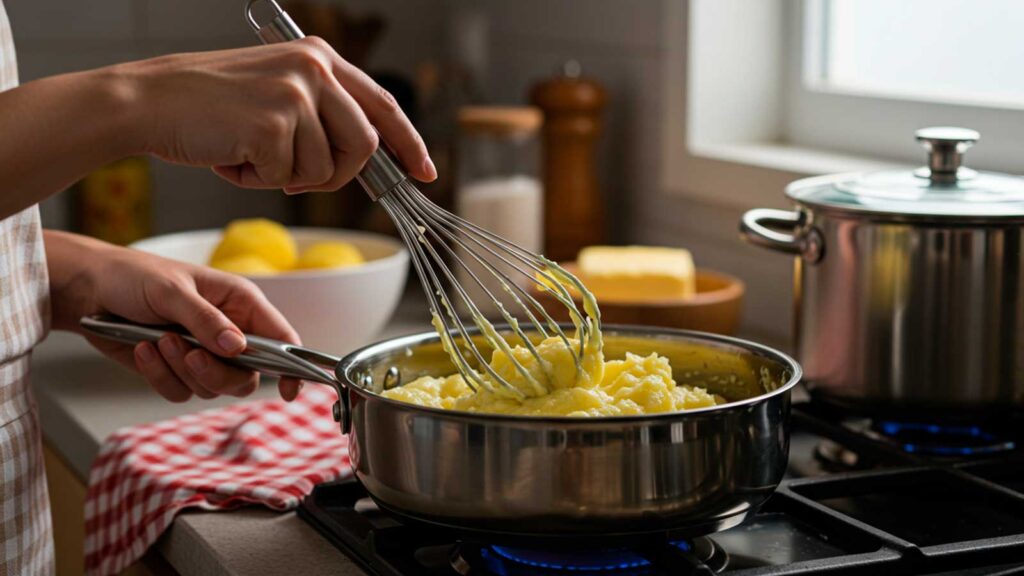Mashed potatoes are one of the most classic homemade side dishes. Easy to make, creamy and full of flavor, they pair well with a wide range of dishes such as meat, chicken and even vegetarian options. In this article you’ll find a traditional mashed-potato recipe, plus variations, preparation tips, fun facts and more.
Traditional Mashed-Potato Recipe
Below you’ll find a straightforward, practical recipe for homemade mashed potatoes, with exact measurements and step-by-step instructions.
Ingredients:
- 1 kg of potatoes
- 1 tablespoon of salt
- 2 tablespoons of butter
- 200 ml of whole milk
- A pinch of black pepper (optional)
- Freshly grated nutmeg to taste (optional)
Method of Preparation:
- Wash the potatoes thoroughly with their skins on and place them in a pan with cold salted water.
- Bring to medium heat and cook until tender, about 25–30 minutes. Check with a fork.
- Drain and peel the potatoes while still hot, taking care not to burn yourself.
- Mash the potatoes well with a ricer or hand masher. Avoid using a blender or food processor, which can make the mash gluey.
- In a saucepan melt the butter, then add the mashed potatoes.
- Gradually pour in the warm milk, stirring constantly until you get a smooth, creamy mixture.
- Season with black pepper and nutmeg if desired.
- Cook for another 2–3 minutes, stirring well, and serve the mashed potatoes piping hot.
Tips to Make Mashed Potatoes Even Better
Mashed potatoes may look simple, but a few details make all the difference. Check out these golden tips to make your mash creamier, tastier and praise-worthy:
- Use Asterix potatoes
This variety has less water and more starch, giving a firmer texture—perfect for a smooth, consistent mash.
- Never add cold milk
Always warm the milk before incorporating it. This prevents the mash from cooling and turning grainy. Warm milk blends better and enhances creaminess.
- Choose high-quality butter
Butter provides much of the flavor in mashed potatoes. Use real, full-fat butter for a richer, authentic taste. Avoid margarine and low-fat spreads.
- Add fresh heavy cream at the end
For a richer version, finish with a spoonful of fresh heavy cream. It makes the mash extra velvety.
- Season with freshly grated nutmeg
A pinch of nutmeg gives a sophisticated aroma that pairs perfectly with potato and milk. Use sparingly.
- Finish with truffle or herb-infused olive oil (optional)
If you want to impress, drizzle a few drops of flavored oil over the mash just before serving. Besides the beautiful look, the taste is surprising.
- Don’t overwork the mash
Excessive stirring—or using devices like immersion blenders—breaks the potato starch and makes the mash heavy and elastic.
- Heat well before serving
If mashed potatoes cool down, they lose some of their ideal texture. Reheat over low heat, adding a splash of milk or butter to restore creaminess.
- Serve in a warmed dish
This prevents the mash from cooling too quickly at the table. Simply warm the serving dish with hot water for a few minutes beforehand.
- Add a touch of creamy cheese
For an even smoother texture, fold in a spoonful of cream cheese or requeijão at the end. It’s irresistibly creamy.
- Avoid excess liquid
Pour the milk gradually until you reach the ideal consistency. Too much milk will make the mash watery and loose.
- Adjust the consistency patiently
Each potato has a different moisture level. Add butter and milk little by little, tasting and adjusting until it’s just right.
With these tips your mashed potatoes will reach a whole new level. Small details turn a simple recipe into the star of the meal.

Mashed-Potato Variations
Mashed potatoes are the perfect base for creative twists. Try the versions below:
Garlic mashed potatoes
Sauté 2 cloves of minced garlic in butter before mixing with the potatoes. It adds a rustic, fragrant note.
Cheesy mashed potatoes
Add 100 g of grated Parmesan or mozzarella during preparation. It melts in beautifully and tastes amazing.
Herb mashed potatoes
Fold in parsley, chives or fresh thyme for a more aromatic mash.
Mashed potatoes with sweet potato
Swap half of the regular potatoes for sweet potato to get a sweeter flavor and a different color.

What to Serve with Mashed Potatoes
Mashed potatoes pair with countless dishes, from the simplest to the most elaborate. Here are some ideas:
- Steak with onions
- Beef or chicken stroganoff
- Roast chicken
- Grilled Tuscan sausage
- Shepherd’s pie with dried beef or shredded chicken
- Meatballs in homemade sauce
Because it’s neutral and creamy, it goes well with salty dishes, rich sauces and roasted or grilled meats.
How to Repurpose Mashed Potatoes
Leftover mashed potatoes? Don’t throw them away. Turn them into new dishes:
Mashed-potato fritters
Mix with a little wheat flour and grated cheese, shape into balls and fry until golden.
Shepherd’s pie
Use the mash as a topping for shredded meat, bake until golden and you’ve got a complete meal.
Potato gnocchi
Add flour and an egg yolk to the mash, roll into logs, cut into pieces and cook in boiling water.
Can You Freeze Mashed Potatoes?
Yes, you can freeze mashed potatoes if they’re stored properly:
- Let them cool completely before freezing.
- Store in lidded containers, leaving space for expansion.
- To thaw, heat in a saucepan with a splash of milk to restore creaminess.
Common Mistakes When Making Mashed Potatoes
Even though it’s simple, making mashed potatoes takes a bit of care:
- Using soft, overly moist potatoes.
- Adding too much milk, making the mash runny.
- Not mashing the potatoes thoroughly, leaving lumps.
- Overheating the milk and curdling the mixture.
- Using improper tools (like a blender).
Fun Facts About Mashed Potatoes
- The original French name is “purée de pommes de terre.”
- It’s a traditional dish for Thanksgiving in the United States.
- Instant mashed potatoes, sold in flakes, were created in the 1950s.
- In many culinary schools, mashed potatoes are one of the first recipes students learn.

FAQ – Frequently Asked Questions about Mashed Potatoes
What is the best potato for mash?
Asterix potatoes are the top choice because they’re drier and easier to mash.
Can you make mash with regular white potatoes?
Yes, but the result will be a bit wetter.
Can I use plant-based milk?
Absolutely! Oat or cashew milk works well, especially for vegan versions.
Can I make mash without milk?
Yes—replace it with the potato cooking water or vegetable broth.
How do I make the mash fluffier?
Mash the potatoes while hot and fold the ingredients gently without overmixing.
READ ALSO:
- Learn How to Make Alfajor at Home
- Natural Yogurt: Discover the Benefits and How to Make It at Home
- Vaca Atolada: A Classic of Brazilian Cuisine
- Petit Gateau Recipe: Learn to Make It at Home
JOIN OUR RECIPE GROUP
WE ARE ON PINTEREST
I hope you enjoyed it